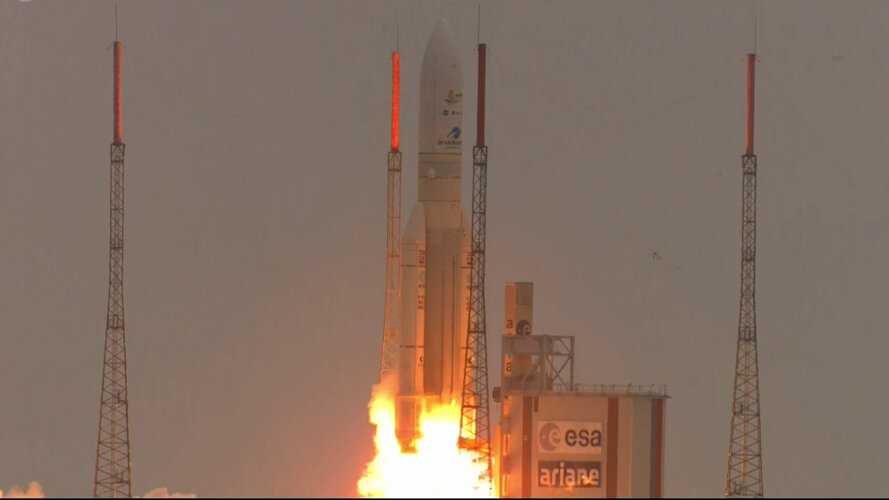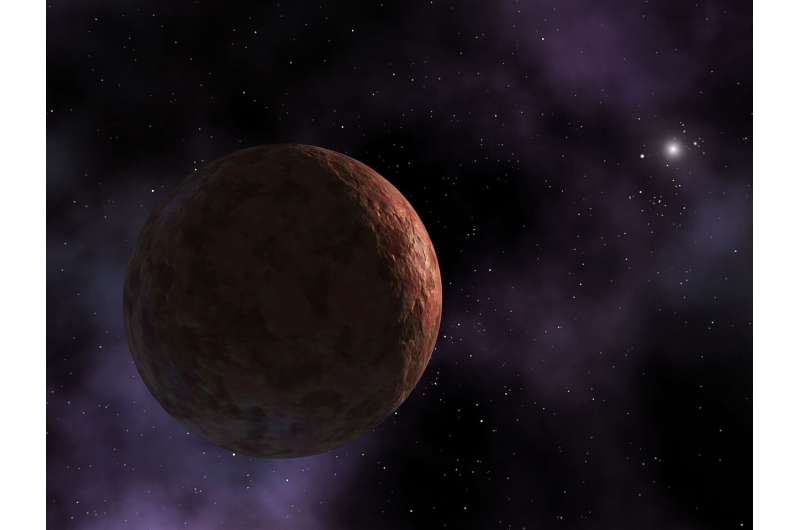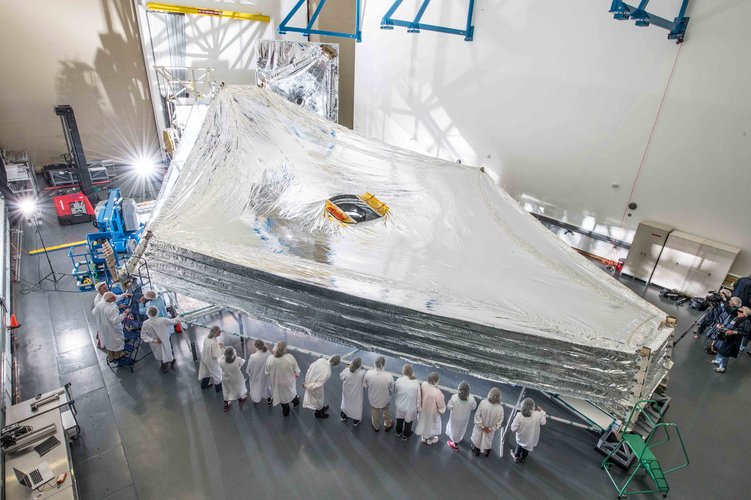
Copernical Team
Webb launch campaign highlights
 Video:
00:01:51
Video:
00:01:51
Highlights of the launch campaign for the James Webb Space Telescope, from its arrival at Europe’s Spaceport in Kourou, French Guiana, weeks of launch preparations, to launch on board an Ariane 5, and separation of the spacecraft and solar panel deployment.
Now in space and on its way to L2, Webb will undergo a complex unfolding sequence. In the months after, the instruments will be turned on and their capabilities tested. After half a year in space, Webb will start its routine science observations.
Webb will see farther into our origins: from the Universe's first galaxies, to the birth
2029 will be the perfect year to launch a mission to Sedna

Object 90377 Sedna—a distant trans-Neptunian object known best for its highly elliptical, 11,390-year long orbit—is currently on its way toward perihelion (its closest approach to the sun) in 2076. After that, Sedna will swing out into deep space again and won't be back for millennia, making this flyby a once-in-a-lifetime (or, once in ~113 lifetimes) opportunity to study an object from the far reaches of our solar system. There are no missions to Sedna in the works just yet, but astronomers are beginning to plan for the possibility, and the ideal launch date for such a mission is approaching fast, with two of the best launch windows coming up in 2029 and 2034.
Sedna was discovered in 2003 by Caltech astronomer Mike Brown and his team, and was one of a series of potential dwarf planets (alongside similar-sized bodies like Haumea, Makemake, and Eris) whose discovery led to the demotion of Pluto in 2006. As best we can tell from a distance, Sedna is about the same size as Ceres, the largest object in the asteroid belt, but its composition and origins are different.
Webb sunshield fully deployed

The NASA/ESA/CSA James Webb Space Telescope team has fully deployed the spacecraft’s sunshield in space, a key milestone in preparing it for science operations.
Kerstin Perez is searching the cosmos for signs of dark matter
 Kerstin Perez is searching for imprints of dark matter. The invisible substance embodies 84 percent of the matter in the universe and is thought to be a powerful cosmic glue, keeping whole galaxies from spinning apart. And yet, the particles themselves leave barely a trace on ordinary matter, thwarting all efforts at detection thus far.
Perez, a particle physicist at MIT, is hoping that a
Kerstin Perez is searching for imprints of dark matter. The invisible substance embodies 84 percent of the matter in the universe and is thought to be a powerful cosmic glue, keeping whole galaxies from spinning apart. And yet, the particles themselves leave barely a trace on ordinary matter, thwarting all efforts at detection thus far.
Perez, a particle physicist at MIT, is hoping that a The mysterious dusty object orbiting TIC 400799224
 The Transiting Exoplanet Survey Satellite, TESS, was launched in 2018 with the goal of discovering small planets around the Sun's nearest neighbor stars. TESS has so far discovered 172 confirmed exoplanets and compiled a list of 4703 candidate exoplanets. Its sensitive camera takes images that span a huge field of view, more than twice the area of the constellation of Orion, and TESS has also as
The Transiting Exoplanet Survey Satellite, TESS, was launched in 2018 with the goal of discovering small planets around the Sun's nearest neighbor stars. TESS has so far discovered 172 confirmed exoplanets and compiled a list of 4703 candidate exoplanets. Its sensitive camera takes images that span a huge field of view, more than twice the area of the constellation of Orion, and TESS has also as Asteroid 'Apophis' predicted to skim dangerously close to Earth in 2029
 Earlier, NASA said that Apophis - the poster child for "hazardous asteroids" - was no longer deemed a threat for Earth based on a refined estimate of its orbit around the Sun.
Asteroid 99942 Apophis, estimated to measure 340 metres (1,100 ft) across and identified by the National Aeronautics and Space Administration (NASA) as one of the most hazardous asteroids that could impact Earth, wil
Earlier, NASA said that Apophis - the poster child for "hazardous asteroids" - was no longer deemed a threat for Earth based on a refined estimate of its orbit around the Sun.
Asteroid 99942 Apophis, estimated to measure 340 metres (1,100 ft) across and identified by the National Aeronautics and Space Administration (NASA) as one of the most hazardous asteroids that could impact Earth, wil Quadrantid meteor shower offers good show outside of North America
 The Quandrantid meteor shower helped kick off the first workday of the new year on Monday, with the peak somewhat tough to see in North America - but the rest of the world got a good show.
The "Quads" as they are nicknamed, are slated to peak around 4 p.m. EDT (2100 GMT) on Monday, according to Margaret Campbell-Brown and Peter Brown in the 2022 version of the Observer's Handbook of th
The Quandrantid meteor shower helped kick off the first workday of the new year on Monday, with the peak somewhat tough to see in North America - but the rest of the world got a good show.
The "Quads" as they are nicknamed, are slated to peak around 4 p.m. EDT (2100 GMT) on Monday, according to Margaret Campbell-Brown and Peter Brown in the 2022 version of the Observer's Handbook of th How scientists designed the orbit of the Chang'E 5 mission
 In the early morning of November 24, 2020, the Chang'E 5 lunar probe was launched from the Wenchang Space Launch Center and successfully executed a 23-day journey of lunar sample return (LSR) mission. In a review paper recently published in Space: Science and Technology, Dr. Zhong-Sheng Wang and his colleagues from the Beijing Institute of Spacecraft System Engineering, addresses three key orbit
In the early morning of November 24, 2020, the Chang'E 5 lunar probe was launched from the Wenchang Space Launch Center and successfully executed a 23-day journey of lunar sample return (LSR) mission. In a review paper recently published in Space: Science and Technology, Dr. Zhong-Sheng Wang and his colleagues from the Beijing Institute of Spacecraft System Engineering, addresses three key orbit China's Mars orbiter captures series of selfies using remote camera
 The China National Space Administration released photos on New Year's Day, of its Mars orbiter circling high above the Red Plant.
The selfies were taken by a small camera which was deployed by the Tianwen 1, capturing images of the orbiter and sending them back to it via a WiFi connection.
The photos were then relayed back to Earth where they were published by China's space agenc
The China National Space Administration released photos on New Year's Day, of its Mars orbiter circling high above the Red Plant.
The selfies were taken by a small camera which was deployed by the Tianwen 1, capturing images of the orbiter and sending them back to it via a WiFi connection.
The photos were then relayed back to Earth where they were published by China's space agenc Sols 3347-3348: Bem Vindo a Roraima!
 Tosol, Curiosity woke up in a new mapping quadrant, Roraima. The Roraima quadrant is named after the northern-most state of Brazil and Mount Roraima, which is the highest peak in the Pakaraima mountains which sits between Brazil, Venezuela, and Guyana.
The terrain in the Roraima region on Earth looks somewhat similar to the area Curiosity is in - with flat-topped hills and some steep slope
Tosol, Curiosity woke up in a new mapping quadrant, Roraima. The Roraima quadrant is named after the northern-most state of Brazil and Mount Roraima, which is the highest peak in the Pakaraima mountains which sits between Brazil, Venezuela, and Guyana.
The terrain in the Roraima region on Earth looks somewhat similar to the area Curiosity is in - with flat-topped hills and some steep slope 